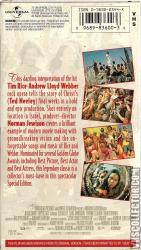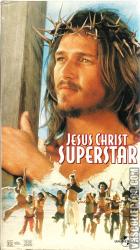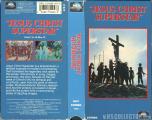Jesus Christ Superstar
Catalog Number
83600
-
Primary Distributor (If not listed, select "OTHER")
Catalog Number
83600
Primary Distributor (If not listed, select "OTHER")
Release Year
Country
N/A (NTSC)
N/A | N/A | N/A
N/A | N/A
Jesus Christ Superstar (1973)
Additional Information
Additional Information
And now, the movie......
The second Biblical epic to be turned into a musical by composer Andrew Lloyd Webber and lyricist Tim Rice, this box-office disappointment recounts the last week in the life of Jesus Christ in rock-opera format and from the surprising point of view of Christ's betrayer, Judas Iscariot. Carl Anderson stars as Judas, who has begun to believe that Jesus (Ted Neeley) has sold out and started buying into the mythology that's quickly springing up around him. Particularly disturbing to Judas is the relationship between Jesus and his friend Mary Magdalene (Yvonne Elliman), a prostitute. When Jesus throws a temper tantrum at the moneylenders in a temple, Judas determines to work with the Pharisees who want to put Jesus on trial as a false prophet. Following his success with the adaptation of Fiddler on the Roof (1971), director Norman Jewison experimented with a hippie-influenced sensibility on Jesus Christ Superstar (1973). Among such touches are depictions of the cast arriving via bus to mount the show, modern high-tech weaponry in the hands of the ancient Romans, and on-location filming in Israel.
Jesus Christ Superstar is a 1973 American musical film directed by Norman Jewison. A film adaptation of the Andrew Lloyd Webber/Tim Rice rock opera of the same name, the film stars Ted Neeley, Carl Anderson and Yvonne Elliman. The film centers on the conflict between Judas and Jesus[2] during the week before the crucifixion of Jesus. Neeley and Anderson were nominated for two Golden Globe Awards in 1974 for their portrayals of Jesus and Judas, respectively. Although it attracted criticism from some religious groups, reviews for the film were still positive
The movie was very popular earning North American rentals of $10.8 million in 1973.[5] Years later the film was still popular, winning a 2012 Huffington Post competition for "Best Jesus Movie."[6]
The film as well as the musical were criticized by some religious groups.[3] A New York Times review said, "When the stage production opened in October, 1971, it was criticized not only by some Jews as anti-Semitic, but also by some Catholics and Protestants as blasphemous in its portrayal of Jesus as a young man who might even be interested in sex."[7]
Tim Rice said Jesus was seen through Judas' eyes as a mere human being. Some Christians[who?] found this remark, as well as the fact that the musical did not show the resurrection, to be blasphemous. While the actual resurrection was not shown, the closing & final scene of the movie conveys the resurrection through symbolism as a lone shepherd is seen leading a long line of following sheep in front of the rising sun alluding to both Jesus as the "Good Shepherd" in concert with the simultaneous image of a rising sun(either to reflect as new beginning and/or symbolizing the rising "son"). Some found Judas too sympathetic; in the film, it states that he wants to give the thirty pieces of silver to the poor, which, although Biblical, leaves out his ulterior motives (see also "Everything's Alright"). Biblical purists pointed out a small number of deviations from biblical text as additional concerns; for example, Pilate himself having the dream instead of his wife, and Catholics argue the line "for all you care, this bread could be my body" is too Protestant in theology, although Jesus does say in the next lines, "This is my blood you drink/This is my body you eat".
In the 1980 book The Golden Turkey Awards by Michael Medved and Harry Medved, Ted Neeley was given an award for "The Worst Performance by an Actor as Jesus Christ".,[8] yet Neeley and Anderson received Golden Globe nominations for their portrayals of Jesus and Judas in the film version and had subsequently gone on to recreate the roles in numerous national stage tours from 1993-2010 (2004 for Anderson, as he died of leukemia).
The final shot of the film includes a hard-to-spot shadowy figure of a man walking across the horizon. The man is Jesus - the film's allusion to the resurrection.
Director Norman Jewison based the "Last Supper" tableau on the famous painting by Leonardo Da Vinci, which is located on a wall of the refectory of Santa Maria delle Grazie in Milan, Italy. In doing so, he managed to give the dancers playing the Apostles specific character names. The only flaw is, the singer who plays "Peter", Paul Thomas, is seated in the wrong place. He is on the end, in the position Da Vinci painted "Bartholomew". In the painting, "Peter" is believed to be the apostle whispering to "John", the apostle seated immediately to Jesus' right, our left.
Release Date: August 8, 1973 @ The Ziegfeld
Distrib: Universal
The second Biblical epic to be turned into a musical by composer Andrew Lloyd Webber and lyricist Tim Rice, this box-office disappointment recounts the last week in the life of Jesus Christ in rock-opera format and from the surprising point of view of Christ's betrayer, Judas Iscariot. Carl Anderson stars as Judas, who has begun to believe that Jesus (Ted Neeley) has sold out and started buying into the mythology that's quickly springing up around him. Particularly disturbing to Judas is the relationship between Jesus and his friend Mary Magdalene (Yvonne Elliman), a prostitute. When Jesus throws a temper tantrum at the moneylenders in a temple, Judas determines to work with the Pharisees who want to put Jesus on trial as a false prophet. Following his success with the adaptation of Fiddler on the Roof (1971), director Norman Jewison experimented with a hippie-influenced sensibility on Jesus Christ Superstar (1973). Among such touches are depictions of the cast arriving via bus to mount the show, modern high-tech weaponry in the hands of the ancient Romans, and on-location filming in Israel.
Jesus Christ Superstar is a 1973 American musical film directed by Norman Jewison. A film adaptation of the Andrew Lloyd Webber/Tim Rice rock opera of the same name, the film stars Ted Neeley, Carl Anderson and Yvonne Elliman. The film centers on the conflict between Judas and Jesus[2] during the week before the crucifixion of Jesus. Neeley and Anderson were nominated for two Golden Globe Awards in 1974 for their portrayals of Jesus and Judas, respectively. Although it attracted criticism from some religious groups, reviews for the film were still positive
The movie was very popular earning North American rentals of $10.8 million in 1973.[5] Years later the film was still popular, winning a 2012 Huffington Post competition for "Best Jesus Movie."[6]
The film as well as the musical were criticized by some religious groups.[3] A New York Times review said, "When the stage production opened in October, 1971, it was criticized not only by some Jews as anti-Semitic, but also by some Catholics and Protestants as blasphemous in its portrayal of Jesus as a young man who might even be interested in sex."[7]
Tim Rice said Jesus was seen through Judas' eyes as a mere human being. Some Christians[who?] found this remark, as well as the fact that the musical did not show the resurrection, to be blasphemous. While the actual resurrection was not shown, the closing & final scene of the movie conveys the resurrection through symbolism as a lone shepherd is seen leading a long line of following sheep in front of the rising sun alluding to both Jesus as the "Good Shepherd" in concert with the simultaneous image of a rising sun(either to reflect as new beginning and/or symbolizing the rising "son"). Some found Judas too sympathetic; in the film, it states that he wants to give the thirty pieces of silver to the poor, which, although Biblical, leaves out his ulterior motives (see also "Everything's Alright"). Biblical purists pointed out a small number of deviations from biblical text as additional concerns; for example, Pilate himself having the dream instead of his wife, and Catholics argue the line "for all you care, this bread could be my body" is too Protestant in theology, although Jesus does say in the next lines, "This is my blood you drink/This is my body you eat".
In the 1980 book The Golden Turkey Awards by Michael Medved and Harry Medved, Ted Neeley was given an award for "The Worst Performance by an Actor as Jesus Christ".,[8] yet Neeley and Anderson received Golden Globe nominations for their portrayals of Jesus and Judas in the film version and had subsequently gone on to recreate the roles in numerous national stage tours from 1993-2010 (2004 for Anderson, as he died of leukemia).
The final shot of the film includes a hard-to-spot shadowy figure of a man walking across the horizon. The man is Jesus - the film's allusion to the resurrection.
Director Norman Jewison based the "Last Supper" tableau on the famous painting by Leonardo Da Vinci, which is located on a wall of the refectory of Santa Maria delle Grazie in Milan, Italy. In doing so, he managed to give the dancers playing the Apostles specific character names. The only flaw is, the singer who plays "Peter", Paul Thomas, is seated in the wrong place. He is on the end, in the position Da Vinci painted "Bartholomew". In the painting, "Peter" is believed to be the apostle whispering to "John", the apostle seated immediately to Jesus' right, our left.
Release Date: August 8, 1973 @ The Ziegfeld
Distrib: Universal
Related Releases3
Catalog Number
83599
Primary Distributor (If not listed, select "OTHER")
Jesus Christ Superstar (1973)
Release Year
Catalog Number
83599
Primary Distributor (If not listed, select "OTHER")
Catalog Number
83599
Catalog Number
BTA55002
Primary Distributor (If not listed, select "OTHER")
Jesus Christ Superstar (1973)
Release Year
Catalog Number
BTA55002
Primary Distributor (If not listed, select "OTHER")
Catalog Number
BTA55002
Catalog Number
55002
Primary Distributor (If not listed, select "OTHER")
Jesus Christ Superstar (1973)
Release Year
Catalog Number
55002
Primary Distributor (If not listed, select "OTHER")
Catalog Number
55002













Comments0
Login / Register to post comments